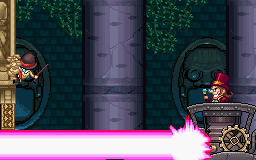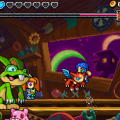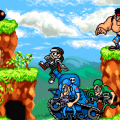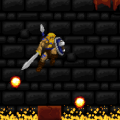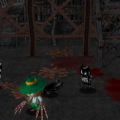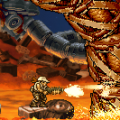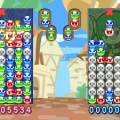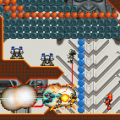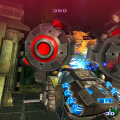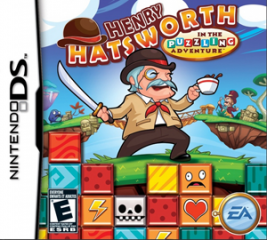
American Nintendo DS Cover
When it comes to creativity, EA isn’t really one of the first company at the top of the list. In fact, it isn’t even at the bottom of the list, and it’d be lucky to be on the part of the list that ended up in tiny shreds on the floor. Ever so rarely, however, there will be points when EA will be just a little less evil than usual, and it’s times like this when we get games like Mirror’s Edge and the original Dead Space. Henry Hatsworth in the Puzzling Adventureis one of these games, the sort of thing you’d never expect to see from EA’s Tiburon team in a million years. EA Tiburon, for reference, are the division of EA behind the newer Madden titles, which, however much of a fan of the sport you are, could never be claimed to be bursting with originality. How something like this game came from them is a mystery, but it should be appreciated all the same.
The game stars Professor Henry Hatsworth, an aging explorer, number one member of the Pompous Adventurer’s Club, and a native of jolly old Tealand. While on an expedition in the jungle, Henry encounters a mysterious hat inside some ancient ruins. While the hat restores his youth and makes him look much more dapper, it also tears a hole open to the Puzzle Realm, a strange dimension full of monsters and treasure. Without the Master Piece, the most powerful part of the golden suit, the Puzzle Realm will continue to grow until it engulfs the entire planet. With the Puzzle Realm threatening the entire world, the only way to seal it once more is for Henry to find all the pieces of the legendary Golden Suit, scattered across the world. Assisted by Cole, a plucky youth with a gift for machinery and generally being a snarky brat, Henry sets off on a globe travelling adventure. Meanwhile, Henry’s dastardly rival, Leopold Charles Anthony Weaselby the Third, is constantly sending out henchmen and building new machines in an attempt to find the Master Piece first.
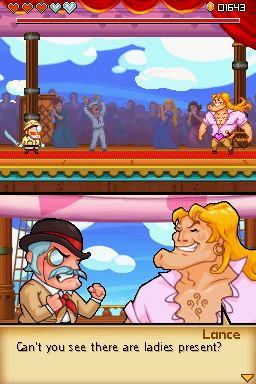
It’s a simple plot, sure, but it’s pretty entertaining, mostly for how goofy the characters and dialogue are. Henry’s the stereotypical British explorer who uses phrases like “Poppycock!” unironically, and he’s also sometimes pretty oblivious to the goings on around him. Given the dynamic of a puzzle-solving explorer and his young sidekick, the whole thing almost feels like some kind of Bizarro universe version of Professor Layton that involves beating things up with swords. Cole and Luke, while they both as young sidekicks to a puzzle solving professor, also have one very big difference to them that isn’t revealed until much later. The plot’s generally never that important to the game itself, but the game never takes itself seriously at any point, which makes some of the bosses a real joy to fight. The number of EA games that let you fight a senile Southern general who is used as a bludgeon by his nurse are sadly very, very few, so it deserves credit for that alone.
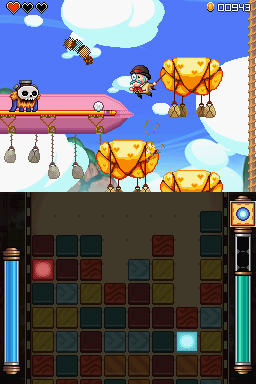
The simplest way to describe the game itself the best parts of Mega Man X‘s combat and movement, with a hint of Castlevania‘s platforming for good measure. Not the most original way to describe it, of course, but not entirely inaccurate. From the start, Henry begins with a single jump and a multitude of combat moves he can pull off with his sword and cane. Unusually for a 2D platformer, there’s actually quite a lot of combat, so learning to use these moves to the best of your ability will really help in the later levels. One of Henry’s more useful moves is his launcher, which can be used to send enemies airborne where they can be smacked around for extra damage. As far as the melee combat goes, it’s not quite up to the level of depth as something like as Devil May Cry, but it works pretty well, mostly because enemies go down too quickly for it to get boring.
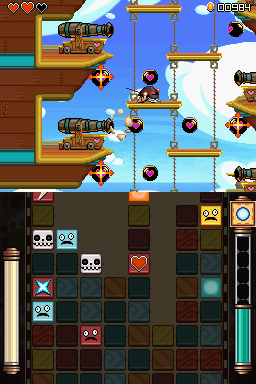
Besides the melee attacks, Henry can also use his hunting rifle to fire off projectiles with the A button. The primary weapon that you start the game with fires Mega Man-style pellets to blast enemies at range with. As you progress, however, you can find different powerups that’ll switch the current projectile you have equipped. Bombs have a short range, but they can hit things in low places and do more damage, while the boomerang weapon hits multiple times and can go through walls, but lacks power. You can also perform a special attack with your current by hitting Up and A together, like giving Henry a shield of boomerangs that rotate around and hit enemies near him. These can do a lot of damage, but they’ll suck your energy meter dry quickly.
By hitting the X button or tapping the bottom screen with the stylus, the action on the top screen will pause, and the game will switch to the puzzle board on the bottom screen. This is where the “puzzling” part of “Puzzling Adventure” comes into play, and if the main game will remind some people of Mega Man X, the Puzzle Realm is definitely going to give people some big Tetris Attack flashbacks. During the game, whether you’re in the bottom screen or not, blocks of various colors will slowly rise upward, pushing up anything above them. You can move the cursor on the bottom screen by either using the D-Pad, or your stylus, if you prefer. By the hitting the B button or swiping over two tiles, you can swap them around, or move tiles over an empty space. Blocks are also affected by gravity, so you can move tiles downwards by shifting them towards an empty column. By matching three blocks of the same color, they’ll disappear, and you’ll get a little energy. If you can make several matches in a row, you’ll make a chain, and you can earn even more energy.
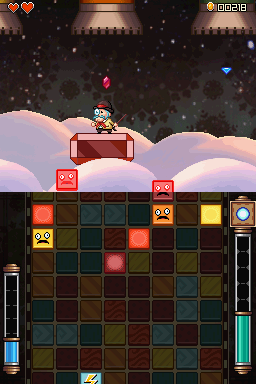
Any powerups you collect on the top screen, like health or extra lives, will place themselves on one of the blocks on the bottom screen, so you’ll have to match them if you want their benefit. Some blocks contain power-ups, that when matched, will give you a beneficial effects on both screens. The hourglass icon, for example, will temporarily stop the board from moving up, but it’ll also freeze enemies in place for a few seconds, giving you a free shot at them. The thing is, however, the Puzzle Realm isn’t all good news. The puzzle meter on the left of the bottom will slowly drain as you stay on the bottom screen, and if it runs out entirely, you’ll get kicked back to the top screen. It’s not too restrictive, since you can earn more puzzle meter by making matches and doing more damage, so it’s more of a reminder to not dally too much while you’re on the bottom screen. And then you have to deal with the monster blocks, which turn the puzzle realm from something that gives you free powerups into… well, half the game.
Any time you kill a monster, there’s a very high chance they’ll move down to the bottom screen and inhabit one of the blocks below. If a normal block or a block with a power-up makes it all the way out of the bottom screen, nothing happens. If a monster block escapes the bottom screen by moving all the way to the top of it, though, it’ll escape and start attacking you on the top screen. The good thing is that only one rogue monster block can be on the top screen attacking you at once. This doesn’t mean that you should ignore them, though, because just one rogue block can be one more thing to throw you off in the middle of combat or during a spot of tricky platforming. Different classes of enemies leave behind different monster blocks on the board, and each type has a different way of messing you up no matter what screen they’re on. Skull blocks can only be matched with or more of their own kind, and like to home in directly on Henry. Even worse are the locked blocks, with can’t be moved by the cursor, and given the chance, will float over Henry and try to spray poison gas on him that’ll show him down. There’s plenty more, as well, which makes it so there’s plenty of new stuff to deal with in both parts of the game.
Destroying monster blocks, along with the occasional energy block, will boost Henry’s energy meter, something you’ll want to get as much of as you can. There’s a few things energy can do for you besides powering your special weapons, and there’s a few reasons you’ll want it. Henry starts off every level in his ‘Young’ form, clad in a safari outfit and carrying around a sword. When Henry’s young, he gets extra silver hearts that let him take more damage. If he loses all his silver hearts, however, he’ll return to his old self, lose that extra maximum health, and his energy meter will empty out entirely. If you can redeem this dishonor by filling energy meter to the point where it’s fully blue, however, you’ll return to your young form, complete with a full heal. The meter can also be filled past the blue part, and will slowly start filling with gold, instead. If you manage to fill the meter a second time, you’ll be told that you can tap the touch screen. And what happens then?
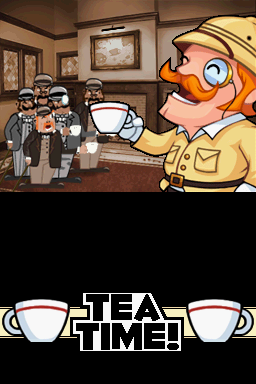
It’s tea time, that’s what happens.
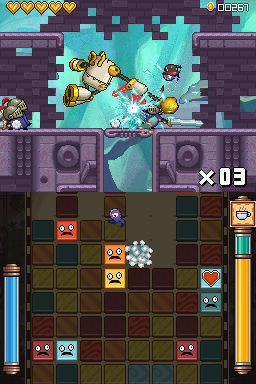
Calling upon all the power of pure Englishness and a hot cup of tea, Henry takes a short break to share a cup of tea with characters like Robin Hood and Sherlock Holmes. (The latter of which happens to be investigating a body, who raises his own cup with them, somehow.) The Turkish March begins to play, before suddenly turning into an awesome heavy metal remix as you summon a set of steampunk power armor. You’re free to control the armor for as long as your energy meter holds out, pummeling away at enemies with your massive, tea-powered fists. Not only do you do much more damage to enemies in robot form, but you’re also mostly invincible, with any damage affecting your energy meter instead. It might just be the greatest super mode in any game known to man.
The puzzle realm has a couple of other helpful applications, as well. If you fire a projectile, and then switch over to the bottom screen while it’s still on screen, you can power it up by making matches. Powered projectiles do more damage have extra effects, like powered-up boomerangs getting homing capabilities once you switch to the touch screen. In the levels themselves, you’ll also come across outline blocks, where you’ll have to make matches on the bottom screen to fill them in for traversal. Some of these blocks can also be destroyed by certain enemy attacks, so you’ll need to keep rebuilding them if you don’t want to end up falling through them.
Overall, the whole puzzle gimmick works out pretty well. The punishment for letting a monster block reach the top screen isn’t so harsh that you have to constantly watch to make make sure it never happens. Since there’s so many different ways the monster blocks can screw up your whole day, however, there are enough reasons for stopping and clearing out a few blocks that you’ll want to do it reasonably often. At some point, it does get a little annoying to have to stop every once in a while and manage the bottom screen, especially when the board gets really thick with monsters. There are times when you’ll just want to ignore it and keep going, and while you’re free to do that, that means more rogue blocks to deal with. Still, the puzzle element ties into the main game well enough that the two fit together pretty nicely, for the most part.
When it comes to the actual platforming itself, it generally works just as nicely as the puzzle element that’s integrated so well with the action. The levels are mostly linear, but there’s a few secrets off the beaten path, if you look around. For the most part, you might find a few hidden treasure chests that earn you extra cash, or a few power-ups. Search deeper, however, and you might find a few passages into the Puzzle Realm itself, where treasure and power-ups will be showered upon you. Every level also has two hidden levels, which offer some of the most brutal, DS-snappingly difficult challenges in a game that’s already pretty hard already, but offer a big monetary reward for finishing. Some of these secrets can only be located with abilities found later into the game, so backtracking, while never necessary to finish the game, can be helpful.
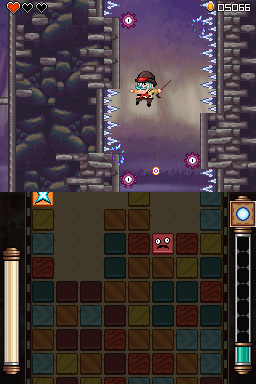
You’ll want to grab as much treasure as you can stay alive with, since these can go towards some very helpful upgrades. Henry’s assistant Cole runs a shop you can reach any time from the map screen, and you can spend whatever treasure you collect from chests and dead enemies. There’s quite a few upgrades, about an equal split of which go towards the top and bottom screen. You might want to increase the damage output on Henry’s different types of attacks, or increase his maximum health. On the other end of things, you can make it so cleared blocks earn you more energy, or increase the chance that health and power-ups will appear in the puzzle. The higher level upgrades get pretty expensive, though, so you’ll have to think carefully before you spend your hard earned money.
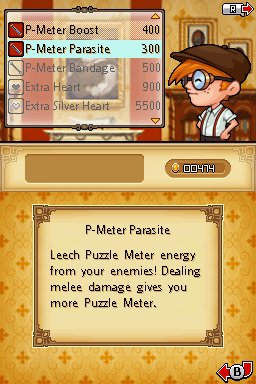
There are five different continents to get through on Henry’s quest to recover the Golden Suit, each of which contains about five stages, with a separate boss stage at the end. The first couple of continents are pretty easy, and throw plenty of challenges your way. It’s by the time you hit the third world that the game goes from being fairly breezy to becoming surprisingly nasty in terms of difficulty. Suddenly, all those extra lives you’ve been gathering become incredibly useful, and you’ll need to rely on the puzzle realm to keep enough energy to survive. In true old-school fashion, hits from enemies tend to knock back Henry pretty far, and you’ll lose more than a few lives from one unlucky hit into a lava pit. It’s a very, very difficult game, sure, but the controls work well enough that it seems entirely fair. It’s actually kind of refreshing, having a platformer where lives actually mean something. The controls, however, are tight enough that pretty much any mistakes are your own, with the only thing really being the game’s fault is the small screen size, meaning you can’t quite always see what hits you.
Half the difficulty comes from the enemies, and just how many different types of them the game throws at you. In the first world or so, your main opposition will be cute, blue blobby things that seem to look constantly terrified. Eventually, though, your face will take that same look when you’re dealing with situations where you’ve got baddies raining projectiles down from the sky, forcing you to move and leap over blobs that explode violently when you get too close, all the while trying to kill one of those giant enemy walls that just won’t die. Every level has at least one or two sections all about combat, where you’ll encounter these situations and more. Every level has at least one room that’ll send in a horde of enemies for you to fight, but compared to a lot of games, the barrage of attacks you’ll have to keep track of mean they’re actually pretty fun. It helps that most enemies go down fairly quickly, so you never have to spam too many combos to clear them out.
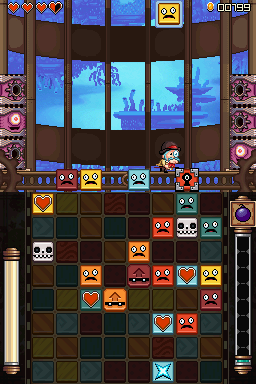
One of the biggest highlights of the game, however, would have to go to the boss battles. The first three continents will put you against one of Weaselby’s henchmen once you reach the end, and their goofy personalities make them a lot of fun to beat up. The first boss is against Lady D, a suspicious widow who attacks you atop a giant wedding cake, and they only get sillier from there, such as the aforementioned senile southern general. While most of the bosses aren’t quite as difficult as the levels before them, they’re all pretty memorable for their weirdness. Most worlds will also have Weaselby show up as a minboss, coming at you in a very Robotnik-esque mechanical hat. With each boss defeated, Henry gets a new piece of the golden suit, which let him perform new abilities like wall jumps and a very Mega Man X-like dash. The end of each world also earns you new moves for your Tea Time, which makes your power armor even more awesome than it already was.
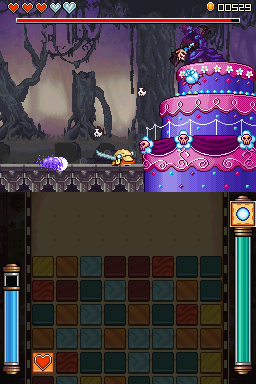
The graphics, while not quite set to the standards of some of the best looking DS games out there, look pretty well. The enviroments and characters are colorful and have a great cartoony style to them, and the game changes the tilesets between worlds fairly frequently, which means things never look too samey. All the enemies also look pretty adorable, for a bunch of otherworldly creatures trying to murder you, including the ones that have skulls for heads. What’s really spectacular, however, is the music. There’s a variety of styles represented through the game, through tango, to heavy metal, to an opera sung by one of the bosses while he’s fighting you, and it’s quite possibly one of the best soundtracks ever composed for a DS platformer. Finding the soundtrack is definitely recommended, especially with how the tracks are held back a little by the DS’s sound hardware.
Overall, Henry Hatsworth in the Puzzling Adventure is definitely somewhere on the top ten when it comes to DS platformers, if not the top five. It takes two very different genres and puts them together in a way that compliment each other incredibly well, and it’s a very unique experience that must be played if you’re a fan of the genre. The only real complaints are the sometimes crushing difficulty, but compared to how much of a breeze even Nintendo’s recent efforts can be, it can be forgiven. Even if you’re the sort of person who avoids EA products, it’s good enough to make an exception for. Pretty amazing, for the guys behind the Madden games.
While the game never ended up getting a sequel, for reasons we can all probably assume, some of the development team went on to found a development studio called DreamRift. Their first game as DreamRift was Monster Tale, another DS game that plays pretty similarly to Hatsworth, with the puzzle game element switched for a monster breeding sim. They also released Micky Mouse: Power of Illusion, a spiritual successor to Sega’s Illusion series. Neither game quite lives up to the level of quality set by Henry Hatsworth, but Monster Tale‘s is worth if you want a little monster breeding in your Metroidvania.
